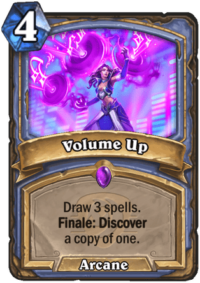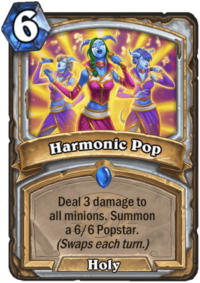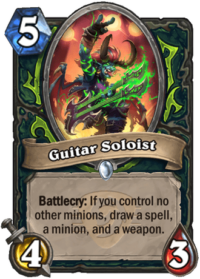The new Hearthstone year will begin with a bang (on the drums) as the ideas of the new Festival of Legends expansion has clearly struck a chord with the community. But how good will it all sound in the end? Will it be a concert for the ages or more like a drunken karaoke night? Let’s dig into the setlist and see what we can find.
Finale(y) A Good Keyword?

Finale is the showstopper of the set, and at first glance, it feels like one of Blizzard’s better creations. Hearthstone has always been very conservative when it comes to introducing new keywords, both in terms of volume and complexity, and sometimes they wildly miss the mark on power levels (Inspire, Overkill and Honorable Kill come to mind). Finale benefits from the added flexibility of the card’s actual cost that it’s printed on, offering another lever to adjust the power levels beyond the reward itself.
The new keyword looks good so far, but maybe it seems a bit underutilized. Many of the Finale cards have a very “filler” feeling to them. In other cases, the effect just seems too weak to make a difference. There are a few standout Finale cards that will very likely see play (such as Thornmantle Musician or Volume Up) but maybe only because they have a very strong base – Finale effect just seems like a nice upside if it triggers, but it’s not necessary to make it work. On the other hand, looking at the Warrior series of Riff cards, they might be unplayable just because you really need to trigger Finale to make them work. And that kind of inflexibility might make them difficult to use successfully.
A word of caution: it’s tough to evaluate these things from the outside. Infuse seemed like the perfect keyword to promote board-centric gameplay and a great reward for marginal gains over the course of multiple trade-centric turns, and it turned out to be an OTK fiesta instead because of a single overtuned card, Sire Denathrius. Much like Infuse cards, the gameplay appeal of Finale will greatly depend on whether playing the cards in non-Finale game states actually make sense. If that is not going to be a realistic decision, it will all become quite boring rather quickly.
Evergreen Twist on a Familiar Theme

Meanwhile, Overheal offers a new and logical direction in the ever-evolving identity of Priest. Veteran Hearthstone players will recall that it was one of, if not the worst classes in Classic: a hodgepodge of Shadow spells and an inconsistent control shell with zero removal options was a huge part of the issue, but there was also the fact that there was no way to leverage the hero power in a proactive fashion (“I hero power and emote!” comes to mind), and even if you did manage to establish a board lead with some sort of a deck, the effect was still not worth the price. Meanwhile, healing face was strictly inferior to Armor Up, and the sort of removal-based control decks Priest could sort of put together became something the developers actively tried to avoid.
This means that the class has to rely on super-heavily pushed tribal archetypes from the latest Standard expansions, leaving little room for flavor and identity. Overheal is a nice way to leverage the otherwise wasted resources of healing and it could be a good method to better incorporate this oft-misused low-tempo mechanic into Priests’ arsenal. It’s flavorful and fitting, but the Overheal cards from Festival of Legends (including the new Core Set cards) feel super janky. Maybe they might see some independent play, but I don’t think that we can build a coherent Overheal deck and make it work. There just seems to not be enough payoff. It might take more time until we can experience the keyword’s glory to the fullest.
Card Flavor Is on Point, but What About Gameplay?
The flavor hits just keep on coming with the Harmonic/Dissonant spells. At first glance, they feel like a throwback to the stat-swapping Worgens from The Witchwood, but since they are spells instead of minions, they come with greater initiative, and are therefore much more likely to be useful, even if you have to play them out in their less-desirable form.

They also serve as a continuation of Hearthstone’s long-standing design trend where the devs are willing to create a lot of added decision points by cranking the randomness dial to eleven, but these decisions almost always only concern you and your hand and finding the optimal way to use your randomly generated resources. With no information available to the other player, it quickly becomes a game of solitaire. Facing five random spells, the best you can do is to blindly try to sequence your cards the best and hope that nothing back-breaking comes back at you. Hand reads have progressively become less and less relevant in modern Hearthstone, and these cards further exacerbate this issue simply based on the polarity of their state. In this case – even if you suspect that your opponent might be holding one of the Harmonic/Dissonant spells, you only have a 50% chance to guess which version they have on any given turn. That might not seem like a big deal, but the difference between suspecting that Priest has a 6 damage AoE and 3 damage AoE is rather major (Harmonic Pop).
Legendary spells are also back, and so are weapons for non-weapon classes (and we’ve seen before how they don’t all act like weapons in practice, making them more of a reskin than a unique gameplay element). From a mechanical perspective, I personally never saw the appeal of these, and Legendary spells come with the added issue of Discover effects, where a card with a power level specifically designed around a single copy can easily show up many times in a single game. This can be especially egregious in formats with lower power levels – just ask Arena players about how bored they are with The Sunwell.

Soloists are odd. Not every class got a card like this, and they are definitely a mixed bag. Seeing one in Shaman is especially weird to me, with Totems and everything, and predictably, Warrior’s got one of the worst ones out there. It’s an interesting but minor gameplay consideration: Hunters can definitely consider giving up some tempo for a turn three secret and a 4/2 body with Harmonica Soloist, Demon Hunters’ Guitar Soloist seems insane, even if it doesn’t mesh well with the whole Rush minion package, and Warlocks’ Opera Soloist seems like a reasonable tool for control decks. The problem is that you can easily find yourself in situations where just cannot trigger the ability, and the vanilla stats are not worth your time. This means that unless you’re a dedicated slowpoke deck with almost no other minions to play out, these might turn out to be a trap card – for yourself.
Also, I’m sure we’re going to hate Mages’ Keyboard Soloist at some point for some reason.
Festival of Legends is 10/10 from a flavor perspective and the new keywords and mechanics fit the bill and are interesting on the surface. At first blush, it seems like the payoffs are mostly not degenerate enough to see Constructed play, even in a post-rotation environment, but I’d be delighted to be proven wrong while I listen to the sweet tunes of DJ Manastorm.
